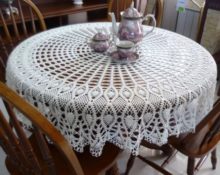 Knitted items made by yourself especially help to create an atmosphere of warmth and comfort in your home. These are various blankets, chair covers, curtains and, of course, napkins and tablecloths.
Knitted items made by yourself especially help to create an atmosphere of warmth and comfort in your home. These are various blankets, chair covers, curtains and, of course, napkins and tablecloths.
Not every craftswoman can completely knit a tablecloth. That's why the best solution is to tie the fabric base with a beautiful lace border. Moreover, in this way it will be possible to obtain not only the traditional rectangle and circle, but you can also give the product an unusual shape.
Knitting borders
In practice, needlewomen use different methods to decorate a tablecloth.
Finish options
There are several ways to crochet a tablecloth trim.
- border of individual elements;
- fillet pattern;
- single canvas.
Finishing from elements can be knitted with single motifs and then assembled into a single piece. Handicraftswoman also can use continuous knitting. In this method, the elements are knitted one after another, for example, as shown in the figure.
Sample continuous method

REFERENCE. In fillet knitting, a pattern is formed by knitting a mesh with hollow or filled cells.
Example of a fillet pattern

And the last method, the most common, is lace fabric, which is obtained using a combination of different patterns.
Lace fabric

IMPORTANT! You can tie a tablecloth by tying the border as you work. But for inexperienced craftswomen it is worth knitting this element separately and then sewing it on.
Selection of yarn and hook
In achieving an excellent final result, the selection of the right material and tools plays an important role.
For tying the tablecloth, you should choose plastic yarn. Linen, cotton and silk are best suited.
It is also worth choosing the color of the threads carefully. If you want to create a product in one color scheme, choose a fiber for the border that is a tone darker than the main color.
A model made in a contrasting manner will also look original.
Example of contrast

Attention! Before starting knitting, wipe the tool with a soft cloth.
The tool is selected according to the thickness of the thread. If you fold it in half, the thickness should be equal to the volume of the hook head.
Knitting options
Separately, it should be mentioned that the strapping can be done without an angle and with this part.
The following decor options are available.
- Tying in a circle. In this case, you can use the last rows of the napkin pattern as a border.
Circular variation pattern

- Border with corner. For tying a rectangular or square base, options with an angle are more often used.
Example of a border with an angle

- Figured option more difficult to manufacture, but it is the most attractive and unusual.
Hexagon figure diagram

How to sew a border to a tablecloth
In order to attach the harness to the main part, two methods are used. We offer a description of each of them.
- The first is the preliminary preparation of the canvas. To do this, the edge is stitched with thread (which you use to knit the binding) according to the pattern;
Example of edge preparation

- The second is to sew the finished part to the canvas. To do this, the edge of the fabric should be processed with a hidden seam or zigzag. Next, stitch the binding along the edge.
Important! For sewing, use a thread of the same tone as the yarn from which the binding is knitted.
Handmade items can add originality and coziness to the interior of your home. They will also tell guests about the creative nature of your character.
Happy creativity and smooth stitches!


 0
0





